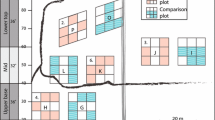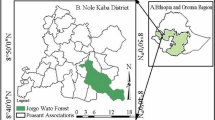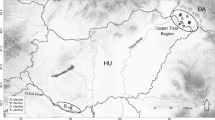Abstract
There is a growing concern for sustainable forest management globally, and individual countries have been developing national policies and plans for forest management. This is the case in Nepal, but a large area of national forests is still under protection due to lack of people-centric management guidelines. In this study, diameter (DBH) and height were measured for trees, and frequency was recorded for regenerations (sapling and seedling), in concentric circular plots of 8.92 m, 5.64 m and 1 m radius respectively, in 89 plots from two community forests in the Mid-hills of Western Nepal to analyze whether the forests could be used sustainably. Regression analysis and the Mann–Kendall and Sen’s slope coefficient tests were performed to determine the composition and structure of forests in relationship with elevation which largely determines forests' type. It was found that seedling density decreases with increasing elevation, but sapling and tree density do not follow any significant pattern for elevation. The DBH size found to be inversely related to stand density for the two dominant tree species (Shorea robusta and Schima wallichii). In contrast, DBH did not vary significantly with elevation for Pinus roxburghii and Castanopsis indica. The DBH distribution of all trees (26 species) was found to decline consistently with stand age, indicating that the forests are in good condition to manage sustainably by a simple, people-centric and cost-effective regime of thinning and size-based harvesting. Results suggest that forest managers, forest users and policy-makers need to develop and implement user-friendly forest management directives.








Similar content being viewed by others
References
Alexandrov GA (2007) Carbon stock growth in a forest stand: the power of age. Carbon Balance Manag 2:4
Awasti N, Bhandari SK, Khanal Y (2015) Do scientific forest management promotes plant species diversity and regeneration in Sal (Shorea robusta): a case study from Lumbini collaborative forest Rupandehi Nepal. Banko Janakari 25(1):20–29
Baishya R, Barik SK, Upadhaya K (2009) Distribution pattern of aboveground biomass in natural and plantation forests of humid tropics in north-east India. Trop Ecol 50:295–304
Baral SG, Vacik H, Chhetri BBK, Gauli K (2018) The pertinent role of forest inventory in choosing silvicultural operations in community forests of Nepal. Banko Janakari (J For Inf Nepal), Spec Issue Silvic 4:6–14
Basnyat B, Treue T, Pokhrel RK (2018) Silvicultural madness: a case from the “Scientific Forestry” initiative in the community forests of Nepal. Banko Janakari (J For Inf Nepal) Spec Issue Ssilvic 4:54–64
Cedamon E, Nuberg I, Paudel G, Basyal M, Shrestha K, Paudel N (2016) Rapid silviculture appraisal to characterise stand and determine silviculture priorities of community forests in Nepal. Small-scale For 16(2):195–218. https://doi.org/10.1007/s11842-016-9351-0
Cedamon E, Paudel G, Basyal M, Nuberg I, Shrestha KK (2018) Applications of single-tree selection guideline following a DBq approach on Nepal’s community forests. Banko Janakari (J For Inf Nepal) Spec Issue Silvic 4:104–112
COP15 (2009) Copenhagen Accord. United Nations Climate Change Conference 2009 in Copenhagen. United Nations Climate Change Conference, Copenhagen
DDC (2011) District profile of Gorkha. District Development Committee, Gorkha
DFRS (2015) State of Nepal’s forests. Forest resource assessment (FRA) Nepal. Department of Forest Research and Survey (DFRS), Kathmandu, Nepal
Gilmour D (2018) Silviculture and community forestry: looking backwards, looking forwards. Banko Janakari (J Ffor Inf Nepal) Spec Issue Silvic 4:6–14
GoN/DoFSC (2018) Community forests database [online]. Department of Forest and Soil Conservation, Community Forest Division, Nepal, Kathmandu (Accessed 21 Aug 2018)
GoN (2019) Forest Act, 2019. Government of Nepal, Kathmandu
GRCFUG (2008) The constitution and operational plan of community forest users group. Ghaledanda Ranakhola Community Forest User Groups, Gorkha
Karpouzos D, Kavalieratou S, Babajimopoulos C (2010) Trend analysis of precipitation data in the Pieria region (Greece). Eur Water 30:31–40
Khanal Y, Adhikari S (2018) Regeneration promotion and income generation through scientific forest management in community forestry: a case study from Rupandehi district, Nepal. Banko Janakari (J For Inf Nepal Spec Issue Silvic) 4:6–14
LDCFUG (2008) The constitution and operational plan of community forest users group. Ludi Damgade Community Forest User Groups, Gorkha
Leuschner WA (1992) Introduction to forest resource management. Malabar, Florida, Krieger Publishing Company
Måren IE, Vetaas OR (2007) Does regulate land use allow regeneration of keystone forest species in the Annapurna conservation area, Central Himalayas? Mt Res Dev 27:345–351
Nasi R, Putz FE, Pacheco P, Wunder S, Anta S (2011) Sustainable forest management and carbon in tropical Latin America: the case for REDD+. Forests 2:200–217
Parkash R (1986) Forest management. International Book Distributors, 9/3, Rajpur Road, Dehradun, 248001, India
Partal T, Kahya E (2006) Trend analysis in Turkish precipitation data. Hydrol Process 20:2011–2026
Poudel KC (2018) Silviculture for forest management in Nepal. Banko Janakari (J Forest Inf Nepal) Spec Issue Silvic 4:15–20
R Core Team (2018) R: a language and environment for statistical computing. R Foundation for Statistical Computing, Vienna
Rubin BD, Manion PD, Faber-Langendoen D (2006) Diameter distributions and structural sustainability in forests. For Ecol Manag 222:427–438
Sen PK (1968) Estimates of the regression coefficient based on Kendall’s tau. J Am Stat Assoc 63:1379–1389
Subedi BP, Pandey SS, Pandey A, Rana EB, Bhattarai S, Baskota TB, Charmakar S, Tamrakar R (2010) Forest carbon stock measurement: guidelines for measuring carbon stocks in community-managed forests. NORAD, ICIMOD, ANSAB, Kathmandu
UN (2015) The Paris agreement. United Nations 2015. United Nations Framework Conventions on Climate Change (UNFCCC)
Upadhyay TP, Sankhayan PL, Solberg B (2005) A review of carbon sequestration dynamics in the Himalayan region as a function of land-use change and forest/soil degradation with special reference to Nepal. Agric Ecosyst Environ 105:449–465
Vetaas OR (2000) The effect of environmental factors on the regeneration of Quercus semecarpifolia Sm. in Central Himalayas, Nepal. Plant Ecol 146:137–144
Acknowledgements
We would like to thank Ms Cathie Roughols for her English editing. We are indebted to Kaushal Raj Gnyawali, Dol Raj Luitel and Reena Chaudhary for their critical feedback on the manuscript, and GRCFUG, LDCFUG, Manoj Bhusal, Kamal Acharya and Nawaraj Paudel for providing tremendous support in fieldwork.
Author information
Authors and Affiliations
Corresponding author
Additional information
Publisher's Note
Springer Nature remains neutral with regard to jurisdictional claims in published maps and institutional affiliations.
Rights and permissions
About this article
Cite this article
Pandey, H.P., Pokhrel, S. Stocking Density and DBH Distribution of Community Forests in Nepal. Small-scale Forestry 20, 145–159 (2021). https://doi.org/10.1007/s11842-020-09461-6
Received:
Revised:
Accepted:
Published:
Issue Date:
DOI: https://doi.org/10.1007/s11842-020-09461-6




